By compensating for a missing copy of SCN2A, one of the genes most strongly linked to autism, a variant of the gene-editing technology CRISPR can reduce susceptibility to seizures, according to a new study in mice.
SCN2A…

By compensating for a missing copy of SCN2A, one of the genes most strongly linked to autism, a variant of the gene-editing technology CRISPR can reduce susceptibility to seizures, according to a new study in mice.
SCN2A…
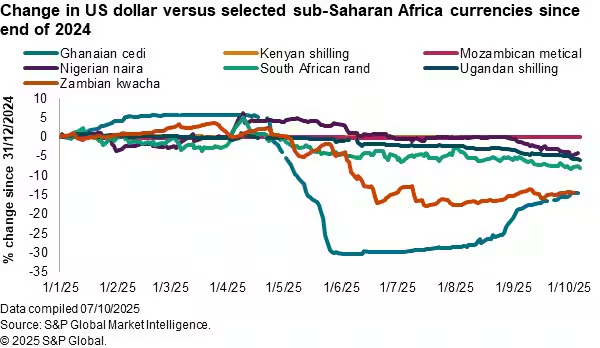
A number of economies in sub-Saharan Africa have seen
inflationary pressures wane in recent months amid currency
appreciation versus the US dollar. In turn, this is allowing
central banks to lower interest rates, helping business activity in
the region to expand solidly. PMI® data and the anecdotal evidence
provided by our survey respondents can help to illustrate the
impact of currency movements.
Of the seven economies in sub-Saharan Africa for which S&P
Global compile PMI surveys, five have seen currency appreciation
against the US dollar over the course of 2025 so far. While this to
some extent reflects the weakness of the dollar itself this year,
there have also been positive factors supporting local currencies,
including support from IMF programmes, fiscal consolidation and
tight monetary policy.
In particular, the Ghanaian cedi and Zambian kwacha have each
appreciated by 15% against the US dollar in 2025 so far, while the
South African rand and Nigerian naira have also seen gains.
Currency appreciation has contributed to a sustained easing of
inflationary pressures in the sub-Saharan Africa business sector.
PMI data showed that overall input costs increased at the slowest
pace since the COVID-19 pandemic in September. While selling prices
rose at a slightly faster pace than in August, here too the pace of
inflation was among the weakest in the past five years.
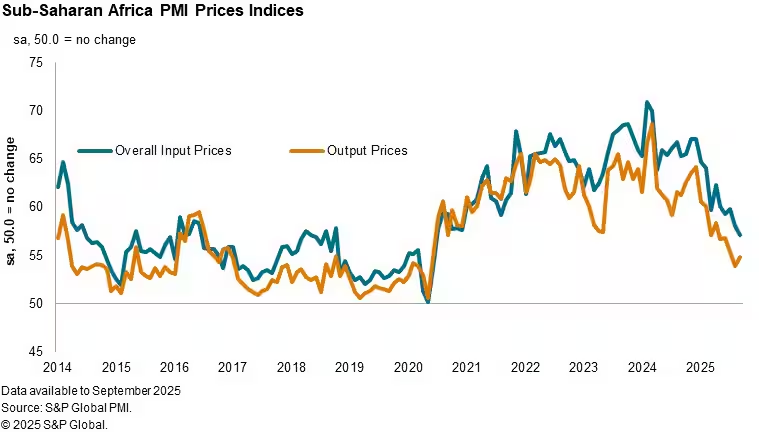
Country level PMI data show that most of the economies we cover
in sub-Saharan Africa have seen either a slowdown in inflation of
purchase costs or outright falls in prices over the course of 2025.
Those countries seeing the strongest currency appreciations against
the US dollar – Ghana and Zambia – have recorded periods of
decreasing purchase prices. Such price falls are rarely seen among
the sub-Saharan Africa PMIs, which normally suffer from marked
inflationary pressures. Even Nigeria, where purchase costs
continued to rise sharply during the third quarter, posted the
weakest pace of inflation since March 2020.
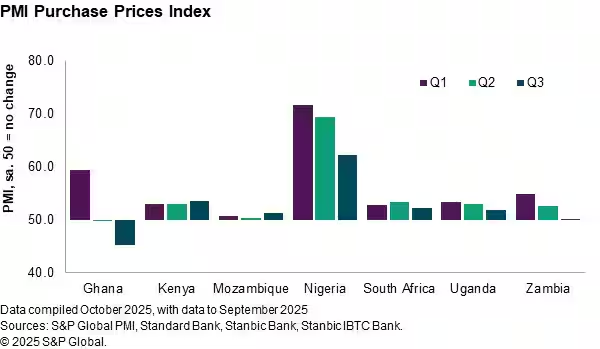
Anecdotal evidence from our PMI surveys can help us to see what
is driving the drop in price pressures in the region, with comments
from panellists highlighting the impact of currency appreciation on
purchase costs.
Normally we see any references to exchange rates or the dollar
being linked to rises in purchase prices as downward pressure on
local currencies feeds through to higher costs for imported items
and those priced in dollars. But between June and August this year
we recorded more mentions of these factors pushing down
prices rather than lifting them; the only time this has been the
case since we have had the full complement of seven sub-Saharan
Africa PMI surveys.
Similarly, recent months have seen above-average mentions of
either exchange rates or the dollar causing a drop in purchase
prices, to a degree second only to that seen in April 2024, when
firms in Kenya were responding to a substantial appreciation of the
shilling against the US dollar.
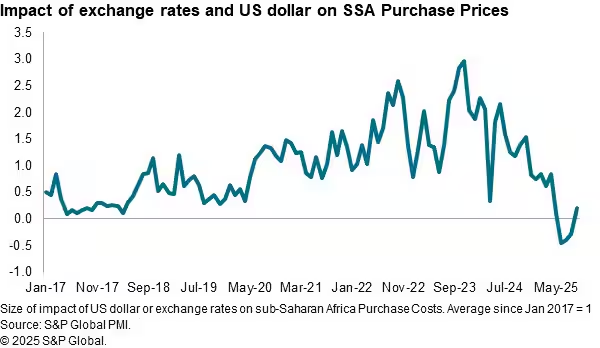
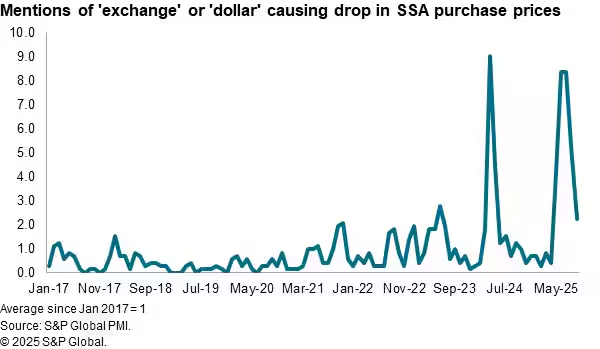
Easing inflationary pressures have enabled central banks across
much of the region to lower their interest rates over the course of
2025. Of the seven economies we cover, five have lower levels of
interest rates now than at the start of the year. Most notably is
Ghana, where the central bank has cut rates by 650 basis points in
the past two meetings. Interest rates in Uganda are at the same
level as they were at the start of 2025, while only Zambia has
posted an increase. Here though, S&P Global Market Intelligence
expects a cut of 50-100 basis points at the upcoming November
monetary policy committee meeting.
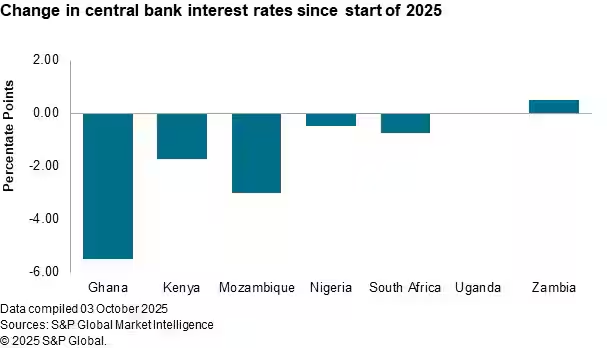
The softening inflation environment has coincided with a period
of solid growth in the sub-Saharan Africa private sector. September
saw output increase at the fastest pace in five months in response
to higher inflows of new orders. Employment rose for the twelfth
month running, while firms increased their purchasing activity and
inventory holdings.
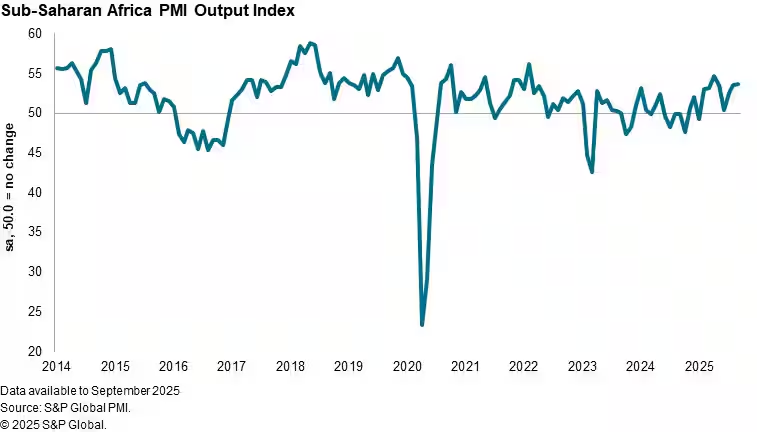
Most notably, the Stanbic Bank Zambia PMI signalled the fastest
rise in business activity since June 2023, while Stanbic Bank PMI
data for Kenya signalled a return to growth following mid-year
disruptions caused by protests. The only economy covered by PMI
data to see a drop in output during September was Ghana, but even
here new orders expanded and business confidence remained elevated,
meaning that we could potentially see renewed growth in the months
ahead.
Overall, the sub-Saharan Africa private sector enters the final
quarter of the year on a solid footing, in part at least due to the
currency gains seen over the course of 2025 so far.
Access the global PMI press releases.
Andrew Harker, Economics Director, S&P Global Market
Intelligence
Tel: +44 134 432 8196
andrew.harker@spglobal.com
© 2025, S&P Global. All rights reserved. Reproduction in
whole or in part without permission is prohibited.
Purchasing Managers’ Index™ (PMI®) data are compiled by S&P Global for more than 40 economies worldwide. The monthly data are derived from surveys of senior executives at private sector companies, and are available only via subscription. The PMI dataset features a headline number, which indicates the overall health of an economy, and sub-indices, which provide insights into other key economic drivers such as GDP, inflation, exports, capacity utilization, employment and inventories. The PMI data are used by financial and corporate professionals to better understand where economies and markets are headed, and to uncover opportunities.
Learn more about PMI data
Request a demo
This article was published by S&P Global Market Intelligence and not by S&P Global Ratings, which is a separately managed division of S&P Global.

Researchers from Osaka Metropolitan University have discovered how the balance of bacteria in the stomach affects the growth of neuroendocrine tumors (NETs). By identifying the specific bacteria involved and the biochemical…

The government has notified draft amendments to the Sharing of Assets of Civil Servants Rules, 2023, on Wednesday, as part of efforts to fulfill the IMF’s governance reform requirements, according to a news report.
The new rules mandate…

Philippines – After debuting in India and Indonesia, OpenAI has expanded its cost-friendly subscription plan, ‘ChatGPT Go’, to 16 countries across Asia, aiming to make access to its GPT-5 model more affordable and widely…

Menopause before the age of 45 (known as early menopause) is associated with an increased risk of an array of serious diseases, including cardiovascular disease and osteoporosis. A new study suggests that it may also force women out…

Might brain damage linked to Alzheimer’s be one of the reasons dolphins lose their way and end up stranded? It’s a possibility explored in a new study of 20 common bottlenose dolphins (Tursiops truncatus) stranded in the Indian River Lagoon,…
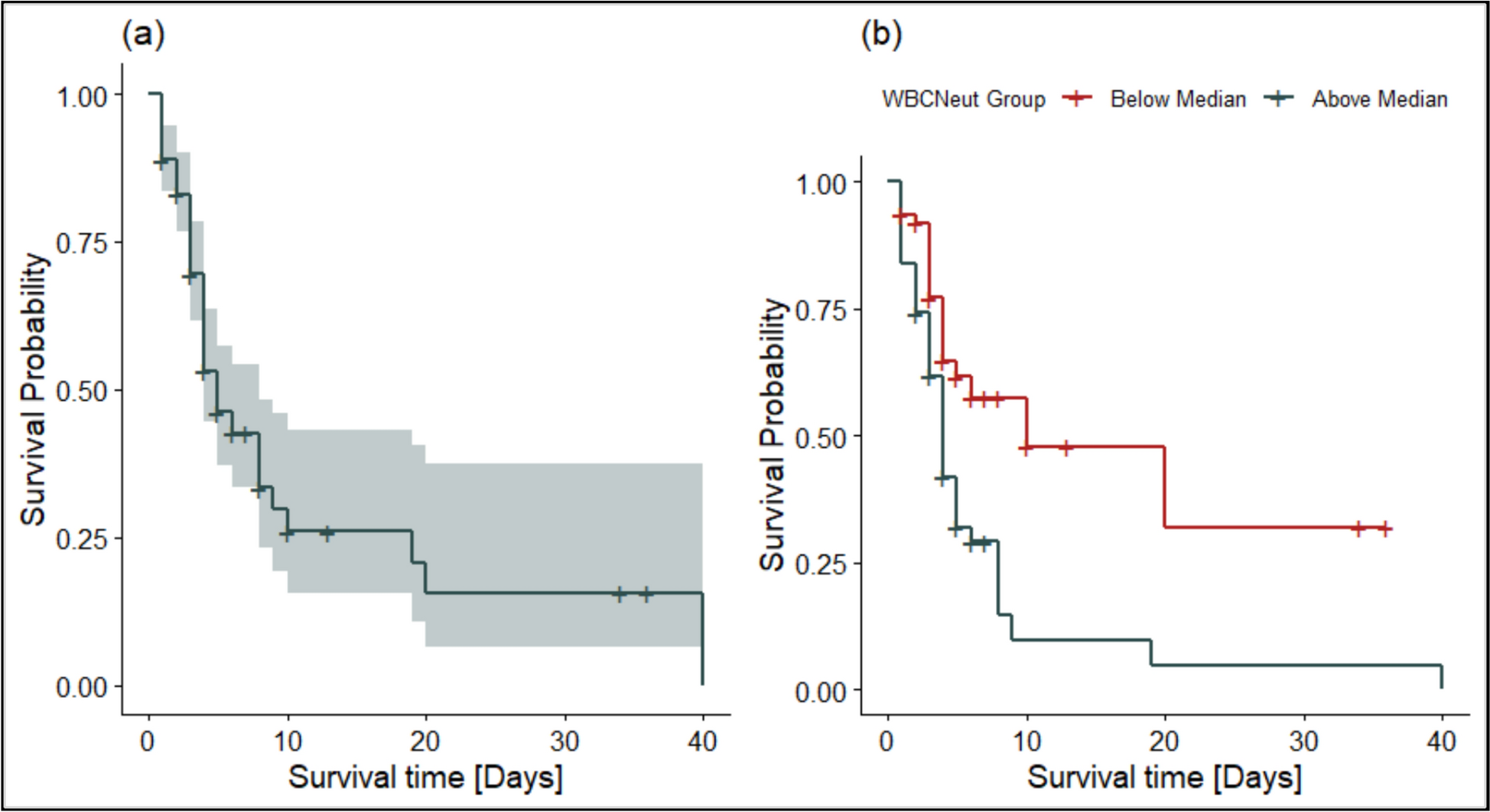
A total of 125 patients were followed up over 40 days. Of these, 56 (44.8%) were females and 67 (53.6%) were males. The proportion of deaths was marginally higher among males (56.7%) compared to females (50.0%), although this difference did not…
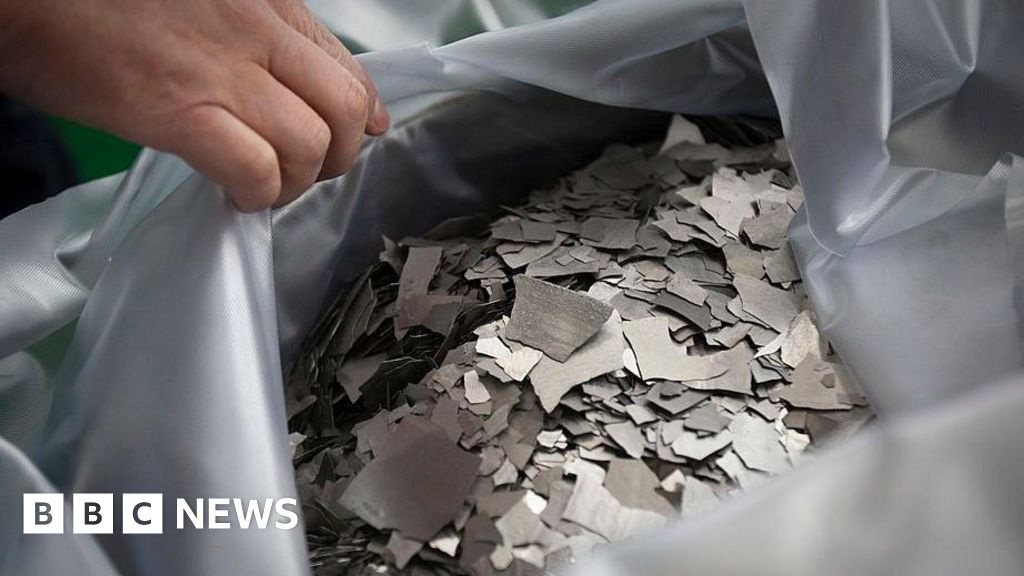
China has tightened its rules on the export of rare earths – the elements that are crucial to the manufacture of many high-tech products.
New regulations announced by the country’s Ministry of Commerce formalise existing rules on processing technology and unauthorised overseas cooperation.
China is also likely to block exports to foreign arms manufacturers and some semiconductor firms.
Rare earth exports are a key sticking point in the months-long negotiations between Beijing and Washington over trade and tariffs. The announcement comes as China’s President Xi Jinping and his US counterpart Donald Trump are expected to meet later this month.
Technology used to mine and process rare earths, or to make magnets from rare earths, can only be exported with permission from the government, the Ministry of Commerce said.
Many of these technologies are already restricted. China had added several rare earths and related material to its export control list in April, which caused a major shortage back then.
But the new announcement makes clear that licenses are unlikely to be issued to arms manufacturers and certain companies in the chip industry.
Chinese firms are also banned from working with foreign companies on rare earths without government permission.
China has been accused by the US and other Western countries of aiding Russia’s war on Ukraine by allowing dual technology exports – materials that can be used for either civilian or military purposes – to be sent to Moscow. Beijing has repeatedly denied this.
The latest announcement also clarifies the specific technologies and processes that are restricted.
These include mining, smelting and separation, magnetic material manufacturing, and recycling rare earths from other resources.
The assembly, debugging, maintenance, repair, and upgrading of production equipment are also prohibited from export without permission, the announcement added.
This could have an impact on the US, which has a significant rare earths mining industry but lacks processing facilities.
Rare earths are a group of 17 chemically similar elements that are crucial to the manufacture of many high-tech products.
Most are abundant in nature, but they are known as “rare” because it is very unusual to find them in a pure form, and they are very hazardous to extract.
Although you may not be familiar with the names of these rare earths – like neodymium, yttrium and europium – you will be very familiar with the products that they are used in.
For instance, neodymium is used to make the powerful magnets used in loudspeakers, computer hard drives, electric car motors and jet engines that enable them to be smaller and more efficient.
China has a near monopoly on extracting rare earths as well as on refining them – which is the process of separating them from other minerals.
The International Energy Agency (IEA) estimates that China accounts for about 61% of rare earth production and 92% of their processing.
Additional reporting by Ian Tang of BBC Monitoring.
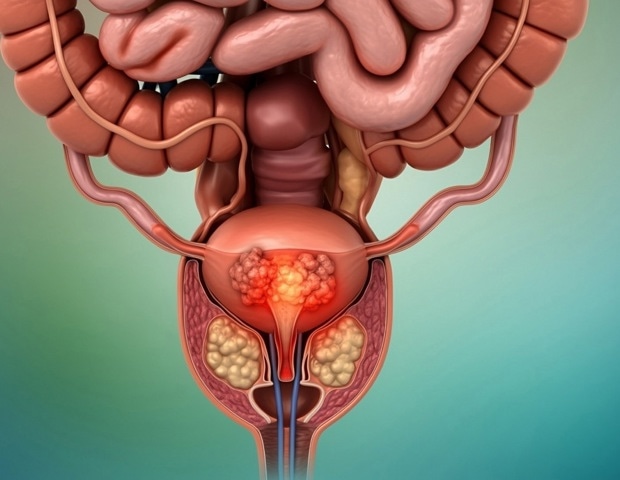
Current prostate specific antigen (PSA) testing “may not effectively target testing to those most likely to benefit, raising concerns about overtesting” warn researchers from the University of Oxford in a study of over 10 million…